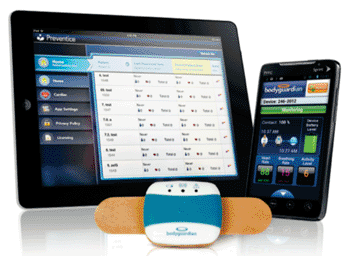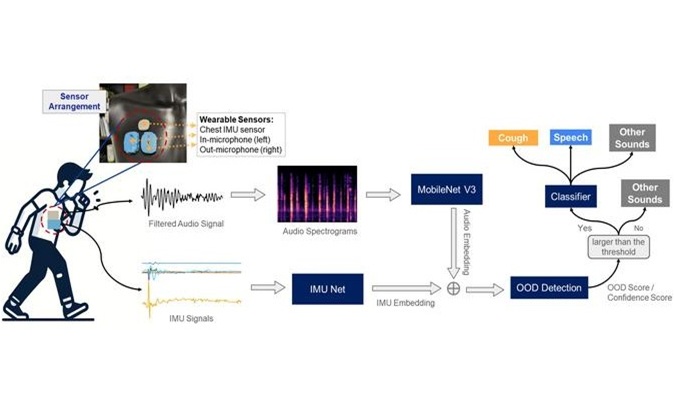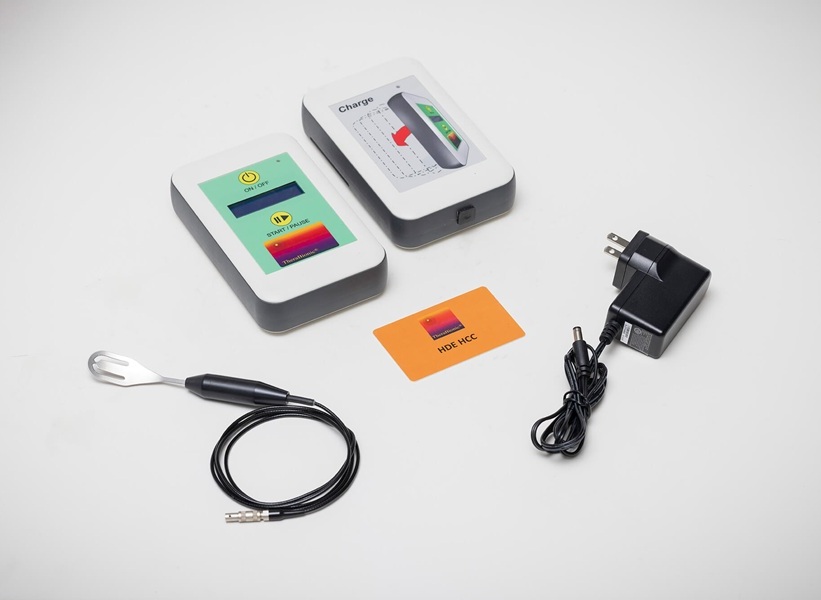Telemedicine System Monitors Key Patient Biometrics
|
By HospiMedica International staff writers Posted on 24 Oct 2013 |

Image: The Preventice BodyGuardian Remote Monitoring System (Photo courtesy of Preventice).
A novel remote monitoring system uses sophisticated algorithms to support observation of patients with cardiac arrhythmias outside of the clinical setting.
The Preventice BodyGuardian Remote Monitoring System comprises a control unit and a highly portable, lightweight wireless body sensor that adheres to the patient’s skin. The bandage-like patch carries a small battery operated monitor sensor that collects the patient’s electrocardiogram (ECG), heart rate, respiration rate, and activity level. Patient data can then be transmitted via mobile phone technology to the Preventice CarePlatform, a cloud-based mHealth platform that collects real-time data from devices and delivers information to medical monitoring professionals.
The biometric data is in turn delivered to physicians and clinicians, who can access their patients’ data and review alerts securely anytime, anywhere via the web or an iPad. Additionally, physicians can set individualized alert thresholds for each patient allowing for individualized tracking and care plan support. The system is scalable, with additional devices that can be used in conjunction with the BodyGuardian to remotely monitor other vital signs such as blood pressure and weight.
Clinical applications of the system include rhythm monitoring to understand the cardiac role of unexplained symptoms; with arrhythmia medication therapy to monitor treatment effectiveness; following ablation procedures to monitor cardiac rhythm; and remote monitoring of cardiac rhythm, respiration, and activity in the hospital or at home for discharged arrhythmia and heart failure patients. The Preventice BodyGuardian Remote Monitoring System is a product of Preventice (Minneapolis, MN, USA), and was developed in collaboration with the Mayo Clinic (Rochester, MN, USA).
“The development of this solution has been a team effort, involving Preventice technology experts, Mayo Clinic physicians, nurses, engineers and technical staff, and the sensor technology leaders at STMicroelectronics,” said Jon Otterstatter, co-founder, president, and CEO of Preventice. “All of these forces have been focused on using remote monitoring technology to change healthcare in a positive way, which is what gives systems like BodyGuardian the ability to improve outcomes, reduce costs, and better engage patients in their care.”
Related Links:
Preventice
Mayo Clinic
The Preventice BodyGuardian Remote Monitoring System comprises a control unit and a highly portable, lightweight wireless body sensor that adheres to the patient’s skin. The bandage-like patch carries a small battery operated monitor sensor that collects the patient’s electrocardiogram (ECG), heart rate, respiration rate, and activity level. Patient data can then be transmitted via mobile phone technology to the Preventice CarePlatform, a cloud-based mHealth platform that collects real-time data from devices and delivers information to medical monitoring professionals.
The biometric data is in turn delivered to physicians and clinicians, who can access their patients’ data and review alerts securely anytime, anywhere via the web or an iPad. Additionally, physicians can set individualized alert thresholds for each patient allowing for individualized tracking and care plan support. The system is scalable, with additional devices that can be used in conjunction with the BodyGuardian to remotely monitor other vital signs such as blood pressure and weight.
Clinical applications of the system include rhythm monitoring to understand the cardiac role of unexplained symptoms; with arrhythmia medication therapy to monitor treatment effectiveness; following ablation procedures to monitor cardiac rhythm; and remote monitoring of cardiac rhythm, respiration, and activity in the hospital or at home for discharged arrhythmia and heart failure patients. The Preventice BodyGuardian Remote Monitoring System is a product of Preventice (Minneapolis, MN, USA), and was developed in collaboration with the Mayo Clinic (Rochester, MN, USA).
“The development of this solution has been a team effort, involving Preventice technology experts, Mayo Clinic physicians, nurses, engineers and technical staff, and the sensor technology leaders at STMicroelectronics,” said Jon Otterstatter, co-founder, president, and CEO of Preventice. “All of these forces have been focused on using remote monitoring technology to change healthcare in a positive way, which is what gives systems like BodyGuardian the ability to improve outcomes, reduce costs, and better engage patients in their care.”
Related Links:
Preventice
Mayo Clinic
Channels
Critical Care
view channel
Origami Robots to Deliver Medicine Less Invasively and More Effectively
Delivering medicine to ulcers or other internal sites often requires invasive procedures that can disrupt surrounding tissues and lengthen recovery times. Traditional magnetic actuators used in soft robotics... Read more
Improved Cough-Detection Technology Aids Health Monitoring
Coughing serves as an important biomarker for tracking a variety of conditions and can help monitor the progress of respiratory diseases or predict when someone’s asthma is being exacerbated.... Read moreSurgical Techniques
view channel
Novel Glue Prevents Complications After Breast Cancer Surgery
Seroma and prolonged lymphorrhea are among the most common complications following axillary lymphadenectomy in breast cancer patients. These postoperative issues can delay recovery and postpone the start... Read more
Breakthrough Brain Implant Enables Safer and More Precise Drug Delivery
Delivering medication directly to specific regions of the brain has long been a major challenge in treating neurological disorders. Current implants and infusion systems typically reach only one or two... Read morePatient Care
view channel
Revolutionary Automatic IV-Line Flushing Device to Enhance Infusion Care
More than 80% of in-hospital patients receive intravenous (IV) therapy. Every dose of IV medicine delivered in a small volume (<250 mL) infusion bag should be followed by subsequent flushing to ensure... Read more
VR Training Tool Combats Contamination of Portable Medical Equipment
Healthcare-associated infections (HAIs) impact one in every 31 patients, cause nearly 100,000 deaths each year, and cost USD 28.4 billion in direct medical expenses. Notably, up to 75% of these infections... Read more
Portable Biosensor Platform to Reduce Hospital-Acquired Infections
Approximately 4 million patients in the European Union acquire healthcare-associated infections (HAIs) or nosocomial infections each year, with around 37,000 deaths directly resulting from these infections,... Read moreFirst-Of-Its-Kind Portable Germicidal Light Technology Disinfects High-Touch Clinical Surfaces in Seconds
Reducing healthcare-acquired infections (HAIs) remains a pressing issue within global healthcare systems. In the United States alone, 1.7 million patients contract HAIs annually, leading to approximately... Read moreBusiness
view channel
Philips and Masimo Partner to Advance Patient Monitoring Measurement Technologies
Royal Philips (Amsterdam, Netherlands) and Masimo (Irvine, California, USA) have renewed their multi-year strategic collaboration, combining Philips’ expertise in patient monitoring with Masimo’s noninvasive... Read more
B. Braun Acquires Digital Microsurgery Company True Digital Surgery
The high-end microsurgery market in neurosurgery, spine, and ENT is undergoing a significant transformation. Traditional analog microscopes are giving way to digital exoscopes, which provide improved visualization,... Read more
CMEF 2025 to Promote Holistic and High-Quality Development of Medical and Health Industry
The 92nd China International Medical Equipment Fair (CMEF 2025) Autumn Exhibition is scheduled to be held from September 26 to 29 at the China Import and Export Fair Complex (Canton Fair Complex) in Guangzhou.... Read more














